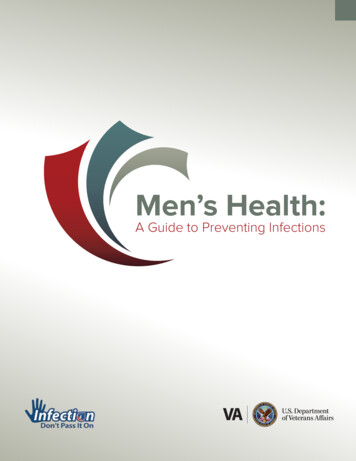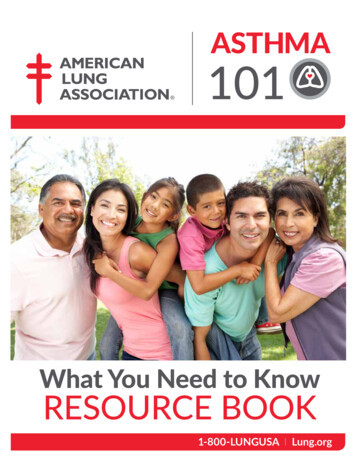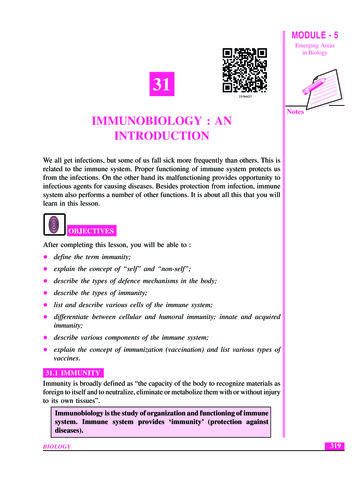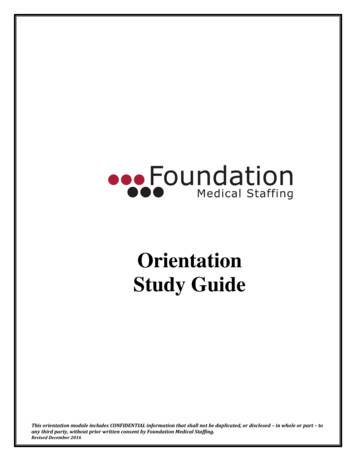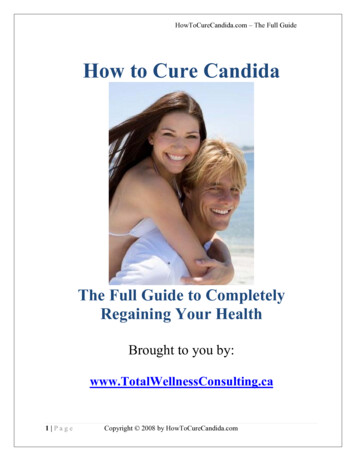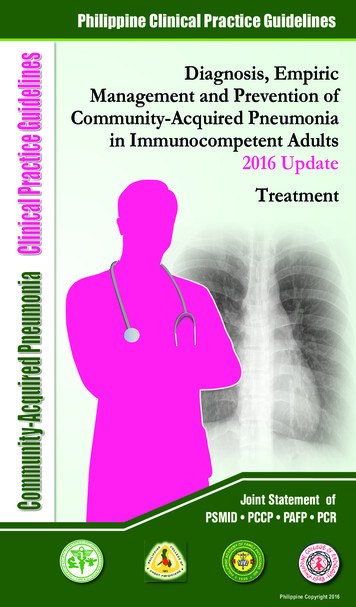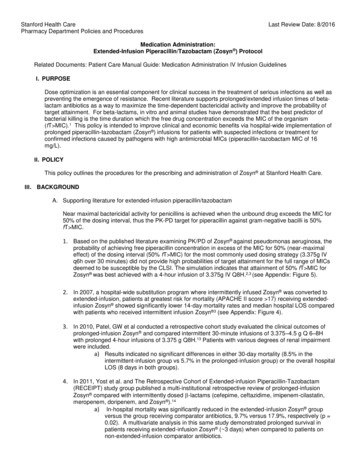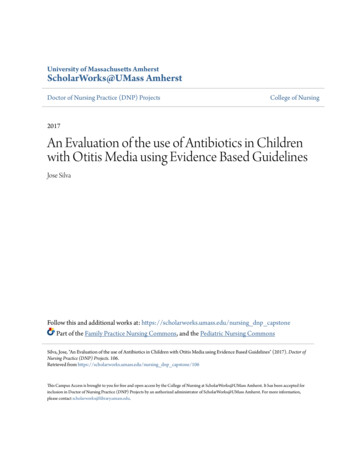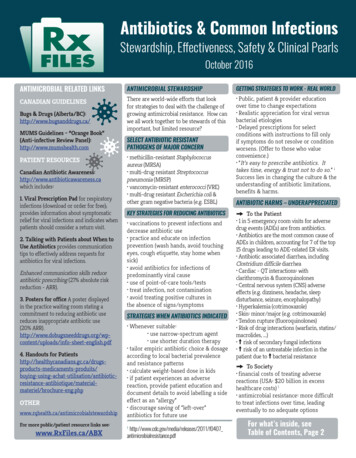
Transcription
Antibiotics & Common InfectionsStewardship, Effectiveness, Safety & Clinical PearlsOctober 2016ANTIMICROBIAL RELATED LINKSANTIMICROBIAL STEWARDSHIPGETTING STRATEGIES TO WORK - REAL WORLDCANADIAN GUIDELINESThere are world-wide efforts that lookfor strategies to deal with the challenge ofgrowing antimicrobial resistance. How canwe all work together to be stewards of thisimportant, but limited resource? Public, patient & provider educationover time to change expectations Realistic appreciation for viral versusbacterial etiologies Delayed prescriptions for selectconditions with instructions to fill onlyif symptoms do not resolve or conditionworsens. (Offer to those who valueconvenience.) “It’s easy to prescribe antibiotics. Ittakes time, energy & trust not to do so.” iSuccess lies in changing the culture & theunderstanding of antibiotic limitations,benefits & harms.Bugs & Drugs (Alberta/BC):http://www.bugsanddrugs.ca/MUMS Guidelines – “Orange Book”(Anti-infective Review Panel):http://www.mumshealth.comPATIENT RESOURCESCanadian Antibiotic Awareness:http://www.antibioticawareness.cawhich includes:1. Viral Prescription Pad for respiratoryinfections (download or order for free);provides information about symptomaticrelief for viral infections and indicates whenpatients should consider a return visit.2. Talking with Patients about When toUse Antibiotics provides communicationtips to effectively address requests forantibiotics for viral infections.Enhanced communication skills reduceantibiotic prescribing (27% absolute riskreduction - ARR).3. Posters for office A poster displayedin the practice waiting room stating acommitment to reducing antibiotic usereduces inappropriate antibiotic use(20% ads/info-sheet-english.pdf4. Handouts for obialstewardshipFor more public/patient resource links see:www.RxFiles.ca/ABXSELECT ANTIBIOTIC RESISTANTPATHOGENS OF MAJOR CONCERN methicillin-resistant Staphylococcusaureus (MRSA) multi-drug resistant Streptococcuspneumonia (MRSP) vancomycin-resistant enterococci (VRE) multi-drug resistant Escherichia coli &other gram negative bacteria (e.g. ESBL)KEY STRATEGIES FOR REDUCING ANTIBIOTICS vaccinations to prevent infections anddecrease antibiotic use practice and educate on infectionprevention (wash hands, avoid touchingeyes, cough etiquette, stay home whensick) avoid antibiotics for infections ofpredominantly viral cause use of point-of-care tools/tests treat infection, not contamination avoid treating positive cultures inthe absence of signs/symptomsSTRATEGIES WHEN ANTIBIOTICS INDICATED Whenever suitable: use narrow-spectrum agent use shorter duration therapy tailor empiric antibiotic choice & dosageaccording to local bacterial prevalenceand resistance patterns calculate weight-based dose in kids if patient experiences an adversereaction, provide patient education anddocument details to avoid labelling a sideeffect as an “allergy” discourage saving of “left-over”antibiotics for future imicrobialresistance.pdf1ANTIBIOTIC HARMS – UNDERAPPRECIATEDQ To the Patient 1 in 5 emergency room visits for adversedrug events (ADEs) are from antibiotics. Antibiotics are the most common cause ofADEs in children, accounting for 7 of the top15 drugs leading to ADE-related ER visits. Antibiotic associated diarrhea, includingClostridium difficile diarrhea Cardiac - QT interactions: withclarithromycin & fluoroquinolones Central nervous system (CNS) adverseeffects (e.g. dizziness, headache, sleepdisturbance, seizure, encephalopathy) Hyperkalemia (cotrimoxazole) Skin: minor/major (e.g. cotrimoxazole) Tendon rupture (fluoroquinolones) Risk of drug interactions (warfarin, statins/macrolides, .) r risk of secondary fungal infections r risk of an untreatable infection in thepatient due to r bacterial resistanceQ To Society financial costs of treating adversereactions (USA: 20 billion in excesshealthcare costs) 1 antimicrobial resistance: more difficultto treat infections over time, leadingeventually to no adequate optionsFor what’s inside, seeTable of Contents, Page 2
Antibiotics & Common Infections – Part 1Table of ContentsCommon Infections – Part 1Stewardship, Effectiveness, Safety & Clinical PearlsBronchitis, AcuteCommunity Acquired Pneumonia (CAP)PharyngitisSinusitis, AcuteAcknowledgements (more details online) .1 .3 .4 .6 .8Oral Antibiotics - GeneralRxFiles is very pleased to acknowledge those whocontributed to Part 1 topic development & review.Overall ABX topic/project guidance:Lynette KosarLoren RegierTessa LaubscherYvonne ShevchukPam KomonoskiLinda SulzJustin KosarCasey PhillipsPharmacist, RxFilesPharmacist, RxFilesFamily Physician, SaskatoonUofS, College of PharmacyRN(NP) UofS Student HealthPharmacist, RQHRPharmacist, SHR StewardshipPharmacist, RQHR StewardshipContent development – ABX Part 1:OverviewPregnancy/Lactation.10.10Oral Antibiotics – Drug Comparison inesFluoroquinolonesAntifolates: Sulfamethoxazole, ntoinFosfomycinLinezolidProbenecid (used to prolong effective levels of cefazolin)VancomycinDealing with Patient’s Expectations & DemandsNon-antibiotic Rx for Predominantly Viral InfectionsWe asked some clinicians Getting patient buy-in.Lynette Kosar*Alex CrawleyAndrew PlishkaRachel MartinLoren RegierPharmacist, RxFiles Topic LeadPharmacist, RxFilesPharmacy Resident, SHRPharmacy Resident, SHRPharmacist, RxFiles Co-LeadTopic input and review:.11.11.12.12.13.13.14Anne NguyenBrent JensenJessica MinionJill Blaser-FarrukhJoe BlondeauJohn AlportJonathan HeyMarlys LeBrasNora McKeeReid McGonigleRoger BristolShaqil PeermohamedTom Smith-WindsorPharmacist, BCPharmacist, RxFilesRQHR MicrobiologyFamily physician, SaskatoonSHR MicrobiologyFamily Physician, ReginaFamily Physician, SaskatoonPharmacist, RxFilesFamily Physician, SaskatoonFamily Physician, Northern SKEmergency Med, SHRMD, SHR Infectious DiseaseFamily Physician, Prince AlbertThe RxFiles academic detailing team (Zack Dumont,Vaughn Johnson, Tanya Nystrom, Lisa Rutherford,Brenda Schuster, Pam Karlson)* Although many contributed to this topic workup,Lynette Kosar took the lead on the 4 primarytherapeutic topic areas, including the overseeingrelated resident rotations. Well done Lynette!!!Graphic design:Debbie Bunka, Colette Molloy (designmolloy.com).15.16Coming up next, Spring 2017ABX – Part 2:Skin Infections, Acute Cystitiswww.RxFiles.caDISCLAIMER: The content of this newsletter represents the research, experience and opinions of the authors and not those of the Board or Administration of Saskatoon Health Region (SHR). Neither the authors nor Saskatoon Health Regionnor any other party who has been involved in the preparation or publication of this work warrants or represents that the information contained herein is accurate or complete, and they are not responsible for any errors or omissions or forthe result obtained from the use of such information. Any use of the newsletter will imply acknowledgment of this disclaimer and release any responsibility of SHR, its employees, servants or agents. Readers are encouraged to confirm theinformation contained herein with other sources. Additional information and references online at www.RxFiles.caCopyright 2016 – RxFiles, Saskatoon Health Region (SHR)Pg 2
ACUTE BRONCHITIS: Management ConsiderationsEMPIRIC DRUG REGIMENS OF CHOICE & SUSCEPTIBILITY CONCERNSAntibiotics are not recommended for acute uncomplicated bronchitis. Multiple studies & meta-analyses assessing antibiotics for the treatment ofacute uncomplicated bronchitis have shown no benefit or modest improvement,along with an risk of adverse events. For example, a 2014 Cochrane review (17 RCTs, n 3,936) evaluating antibiotics(beta-lactams, doxycycline, macrolides, TMP-SMX) vs placebo found nodifference in clinical improvement. Antibiotics cough (NNT 6), night cough(NNT 7) & mean duration of cough by 0.5 days, but risk of adverse events(NNH 5, primarily gastrointestinal related).NONPHARM /maintain hydra on humidity (e.g. PRNhumidifier to maintain30-50% humidity)Honey 2.5 to 10mL po HSNot recommended in 1yr due toconcerns with infant botulismCOUGHSUPPRESSANTSPRE-TREATMENT CONSIDERATIONS Inappropriate antibiotic use is driving resistance & leading to a crisis. Pleaseexamine your own prescribing practices. Refer to newsletter cover. The majority of acute uncomplicated bronchitis cases are viral (90% in adults &95-100% in children). Antibiotics are NOT recommended for acute uncomplicated bronchitis. SeveralRCTs assessing the efficacy of antibiotics for this indication have failed to show abenefit; however, up to 80% of adults in the U.S. still receive an antibiotic. Acute uncomplicated bronchitis is self-limiting. Cough usually persists for 1 to 3weeks, although up to 50% of viral cases will have a cough beyond 3 weeks.Airway hyperactivity may last up to 6 weeks. Recommend symptom management. Acute complicated bronchitis (e.g. history of smoking, impaired lung function,chronic heart disease, immunocompromised) may require further investigation(e.g. lung function tests, chest x-ray). Rule out pneumonia if the following signs are present: HR 100bpm, RR 24breaths/min, oral temperature 38 C, or findings of local consolidation. Coloured sputum does not reliably differentiate between bacterial or viral origin. Fever is uncommon, & may be indicative of influenza or pneumonia. If the patient has confirmed pertussis, see RxFiles pg 78 for antibiotic regimens.Uncommon, but there is the occasional outbreak. Encourage vaccination.MOST COMMON PATHOGENS Viral – e.g. Influenza A, Influenza B, Parainfluenza, RSV, & AdenovirusSYMPTOM MANAGEMENTBRONCHODILATORSPEARLS for the MANAGEMENT of ACUTE UNCOMPLICATED BRONCHITIS Antibiotics are NOT recommended, as bronchitis is predominantly viral. Advise on treatments that will provide symptomatic relief: maintaining hydration& humidity. Cough suppressants may be considered for managing cough, &inhaled bronchodilators if wheezing is present. Honey may help children. Patients should see their prescriber if: 1) symptoms worsen, 2) new symptomsdevelop (e.g. dyspnea, fever, vomiting), 3) cough 1month, or 4) 3 episodes/yr.www.RxFiles.ca Oct 2016Dextromethorphan (DM)e.g. BENYLIN DM, ROBITUSSIN DM10-30mg po q6-8hr PRNno quality evidence, but anecdotally may help- No evidence for or against.- Hydration: caution in HF & CKD patients- Humidifier: clean frequently to risk ofbacteria/fungi growth- No strong evidence for or against.- Cochrane review (3 RCTs, n 568): better thanplacebo, but inferior to dextromethorphan in cough frequency (cough duration not assessed).- May number of coughing episodes but doesnot duration of illness.- Not recommended in children under 6 years ofage due to safety & efficacy concerns. HEALTHCANADASalbutamol VENTOLIN100mcg 2 puffs inhaledQIDIpratropium ATROVENT20mcg 4 puffs QID- Limited evidence (1 study with fenoterol, n 80).- May duration of cough in patients withwheezing/airflow obstruction when used x 1wk(NNT 2, NNH 2 for tremor, shakiness, nervousness).- Limited evidence (1 study, n 14 for 3 weeks) inpost-infectious cough.- May improve daytime & nighttime cough, &dyspnea associated with coughing. Encourage prevention e.g. smoking cessation, exposure to second-hand smoke.Not routinely recommended for symptom management: Oral or inhaled corticosteroids are not recommended in patients with acutebronchitis without asthma. Expectorants (e.g. guaifenesin): most evidence failed to show a benefit.Clinical Q&AShould pts 65yrs be treated with an ABX to the risk of developing pneumonia? No, but patients presenting with signs of pneumonia should undergo investigation(e.g. chest x-ray). A previous retrospective cohort study (1991 to 2001) suggested that individualswith acute bronchitis who were 65 years may benefit from antibiotics (NNT toprevent 1 additional case of pneumonia in the month following acute bronchitiswas 39 for those 65 years, & 199 for those between 16-64 years of age). However, a 2013 RCT (n 1,038) comparing amoxicillin 1000mg po TID x 7 days toplacebo showed no difference in duration or severity of symptoms up to 1 month,regardless of age. There was an risk of adverse events (nausea, rash, diarrhea)with the amoxicillin group (NNH 22).Abbreviations: ABX antibiotic CKD chronic kidney disease HF heart failure NNH number needed to harmNNT number needed to treat RCTs randomized controlled trials TMP-SMX trimethoprim/sulfamethoxazolePg 3
COMMUNITY ACQUIRED PNEUMONIA: Management ConsiderationsPEARLS for the MANAGEMENT of COMMUNITY ACQUIRED PNEUMONIA (CAP) A chest x-ray is recommended to confirm suspected pneumonia.IDSA’07 LOE: moderate The CRB-65 score can be used to help identify adults who may require hospitaladmission due to a higher risk of mortality. S. pneumoniae is the most common bacteria, even in those with comorbidities. Doxycycline covers the majority of bacterial CAP pathogens (e.g. S. pneumoniae,S. aureus, H. influenzae & atypicals). Standard duration of therapy is 5 to 7 days. There is limited data on the role of corticosteroids in outpatients. Recommend the influenza vaccine every fall. Recommend the pneumococcal vaccine x1 for those 65 years of age, or at highrisk regardless of age (e.g. chronic cardiac or pulmonary disease, DM, CKD). Patients should see their prescriber if symptoms worsen or do not improve within48-72 hours. Cough, fatigue or dyspnea may persist for up to 1 month, or longer.PRE-TREATMENT CONSIDERATIONS A chest x-ray is the most accurate way to diagnose CAP, regardless of age. Despite challenges with obtaining a good specimen, a sputum C&S will helpdifferentiate between bacterial versus viral CAP. It can also help identify patientswho may require broader spectrum antibiotics. Rule out influenza during late fall/early spring; consider a nasopharyngeal swab. Review antibiotics associated with higher S. pneumoniae resistance prescribedover the past 3 months. May warrant using an agent from another antibiotic class.OUTPATIENT vs HOSPITAL ADMISSION Several severity of illness scores are available for pneumonia (see RxFiles page 90). Adult Outpatients: the CRB-65 does not require any blood work & can be easilyused in an office setting to identify patients who may require hospital admission.CRB-65CriteriaPointsConfusion: new onset based on a specific mental test, or1disorientation to person, place or timeRespiratory rate 30 breaths/minute1Low Blood pressure: SBP 90mmHg or DBP 60mmHg1Age 65 years1ScoreRisk of MortalitySuggested Management0 2% Outpatient1-2 9% Consider hospital admission 3 19% Hospital admissionIf a recent urea is available, may use CURB-65 where BUN 7mmol/L 1 point.See RxFiles page 90 for information on LTC and pediatric patients.www.RxFiles.ca Oct 2016EMPIRIC DRUG REGIMENS OF CHOICEPREVIOUSLY HEALTHY ADULT OUTPATIENT WITH NO RECENT ANTIBIOTIC USEMost Common Bacterial Pathogen: Gram ve: Streptococcus pneumoniaePotential Pathogens: Atypical pathogens (M. pneumoniae, C. pneumoniae) Based on SK antibiogram data RQHR,SDCL, SHR, doxycycline has good activityDoxycycline200mg po Day 1, then 100mgagainst common/potential CAPpo BID x 5-7 dayspathogens (i.e. S. pneumoniae &atypical pathogens).Amoxicillin:1000mg po TID x 5-7 days S. pneumoniae (even intermediateAmoxicillinsusceptibility isolates) remainClarithromycin preferred if nosensitive to high-dose amoxicillin.major DIs e.g. warfarin, digoxin, Does not cover atypical pathogens.may consider statin, as may result in lessSee Clinical Q&A on whether atypicaladding aresistance than azithro (t½).pathogen coverage is needed.macrolide ifClarithromycin:Macrolides:concerned500mg po BID x 5-7 days, or May be added to amoxicillin to coverabout atypical XL 1000mg po daily x 5-7 daysatypical pathogens. There are concerns with usingpathogensAzithromycin:macrolides as monotherapy due to(see Clinical Q&A) 500mg po daily x 3 days, or S. pneumoniae resistance. 2015500mg po Day 1, then 250mgSK susceptibilities: RQHR 70%, SDCLdaily x 4 days62%, SHR 80% (but 70% in 2014).ADULT OUTPATIENT with COMORBIDITIES / ABX RESISTANT RISK FACTORS*Most Common Bacterial Pathogen: Gram ve: S. pneumoniaePotential Pathogens: Gram –ve: H. influenza, M. catarrhalis, K. pneumoniaeAtypical pathogens: M. pneumoniae, C. pneumoniae, Legionella200mg po Day 1, then 100mg As above, & will also cover S.aureusDoxycycline& potential gram –ve pathogens.po BID x 5-7 daysAmoxicillin- Clavulanate:Amox - Clav875mg po BID x 5-7 daysCLAVULIN This category of patients may be at risk of beta-lactam resistance,may considerwhich is addressed with the additionadding aof clavulanate to amoxicillin.seeabovemacrolidemacrolide re: Does not cover atypical pathogens.options/dosingatypicalSee Clinical Q&A on whether atypicalpathogenspathogen coverage is needed.(see Clinical Q&A)Macrolides: as aboveFluoroquinolones should be reserved for treatment failures, comorbidities withrecent antibiotic use, allergies or documented infections with highly drug-resistantbacteria. Examples: levofloxacin LEVAQUIN 500-750 mg po once daily x 5 daysmoxifloxacin AVELOX 400 mg po once daily x 5 days*Comorbidity or risk factor for ABX-resistant S.pneumoniae: age 65; cardiac, pulmonary,renal or hepatic failure; smoking; alcoholism; malignancy; DM; malnutrition or acuteweight loss ( 5%); immunosuppressive tx including corticosteroid use (high-dose 30days); hospitalization or broad spectrum ABX in past 3 months; HIV/immunosuppressed. ve positive –ve negative ABX antbiotic AMOX-CLAV amoxicillin / clavulanate BUN blood urea nitrogen CAP community acquired pneumonia CKD chronic kidney disease CRB confusion, respiratory rate, blood pressureC&S culture & sensitivity DM diabetes mellitus LOE level of evidence pt patient RQHR Regina Qu’Appelle Health Region SDCL SK Disease Control Laboratory SHR Saskatoon Health Region SK Saskatchewan tx treatmentPg 4
COMMUNITY AQUIRED PNEUMONIA: Management ConsiderationsDuration of Therapy in Adults: Treat for a minimum of 5 days & until afebrile for 48-72hrs. Meta-analyses (15 RCTs n 2,796; 5 RCTs n 1,303) comparing treatment durations of 7 days to 7 days showed no difference in clinical success rates in ambulatory pts. Azithromycin 3 vs 5 days: limited data is available comparing the two regimens, butthere does not appear to be a difference in efficacy or safety. Due to the long t½ ( 68hours in adults), a 3-day course of azithromycin is in essence providing therapybeyond 3 days. Patients may still feel unwell at Day 3; reassure ABX is still working.UNCOMPLICATED* CAP in PEDIATRIC OUTPATIENTS CPS 2015Most Common Pathogens: Infants & pre-school children: viruses are the predominant cause 3 months to 5 years: S. pneumoniae; viruses are still common- due to vaccination, typed H. influenzae as a causative pathogen is very rare CDN 5 years: M. pneumoniae, C. pneumoniaeFIRST LINE Provides best coverage of all betalactams against S. pneumoniae &40-90mg/kg/day po TIDhigher doses cover the majority ofAmoxicillin(max 4g/day) x 7 - 10 dayspenicillin-resistant strains. As such,high-dose should be used in RQHR.PENCILLIN ALLERGY: TYPE IV HYPERSENSITIVITY (e.g. rash) Provides coverage for intermediate20-30mg/kg/day po BIDCefuroximepenicillin-resistant S. pneumoniae.x 7-10 days (max 500mg/dose)OR Treatmentfailure not significantly15-30mg/kg/day po BIDCefprozildifferentcomparedto amoxicillin.x 7-10 days (max 500mg/dose)PENICILLIN ALLERGY: TYPE I HYPERSENSITIVITY (i.e. anaphylaxis) Only use in patients 9 years old. 9 yrs: 4mg/kg/day po BIDDoxycycline(max 200mg/day) x 7 - 10 days It is difficult for pediatric patientsAzithromycin10mg/kg po Day 1 (max 500to produce a sputum sample. Themg/dose), then 5mg/kg pomajority of respiratory isolates aresafety in 6 months daily x 4 days (max 250mg/day)is unknownfrom tracheal suctions &antibiogram data likely does notrepresent pediatric outpatients. Macrolide can be used empiricallyin patients with an anaphylacticpenicillin allergy. If symptomsClarithromycin 15mg/kg/day po BID x 7 - 10worsen or do not improve withindays (max 500mg/dose)safety in 6 months3-5 days, consider addingis unknownclindamycin (20-40mg/kg/day po TID).*uncomplicated acute, CAP in healthy immunized children without underlyingpulmonary pathology aside from mild reactive airway diseaseDuration of Therapy in Pediatrics: The standard duration remains 7-10 days (exception:azithromycin). One small study (n 140, ages 6 months to 5 years) in Israel concludedthat 5 days was not inferior to 10 days, but 3 days was associated with failure rates.www.RxFiles.ca Oct 2016TREATMENT EVIDENCE SUMMARY – ADULT CAPDoxycycline as a 1st line agent Limited evidence with doxycycline for CAP. However, it has S. pneumoniae,H. influenzae, S. aureus & atypical coverage; achieves high serum & lung drugconcentrations; and has concentration dependent killing. Monotherapy sufficient for most, although some Canadian references suggest theoption of combining doxycycline with a beta-lactam due to concerns with doxycyclineresistance to S. pneumoniae. Currently, S. pneumoniae has good susceptibility todoxycycline in Saskatchewan, & therefore the combination is not necessary. Most guidelines suggest a BID (200mg Day 1, then 100mg BID) regimen; however100mg po BID Day 1 followed by 100 mg daily may be suggested due to its long-halflife (12hr after first dose, 24hr with multiple doses). Data comparing the efficacy of thetwo regimens is limited. Anecdotally, twice daily is generally tolerable.Vaccinations: Recommend an annual influenza vaccine, as this can the relative risk of pneumoniaby 53%, hospitalization by 50% & mortality by up to 68% observational data, in those age 65. Recommend a PNEUMOVAX-23 vaccine for those 65 years of age, or at high riskregardless of age (e.g. DM, CKD, chronic cardiac or pulmonary disease, LTC resident,immunocompromised).- Over a 2 year period, PNEUMOVAX-23 prevents 1 case of pneumonia for every 12immunized LTC residents.- PREVNAR-13 studies showed a in invasive pneumococcal disease, but not overallpneumonia rates.- Neither vaccine type has been shown to pneumonia-specific or all-cause mortality.- A PNEUMOVAX-23 booster ( 5 years) may be considered in high risk individuals,although data is limited and based on the theoretical in immunity over time.Clinical Q&AWhen is coverage for atypical pathogens needed? Atypicals are thought to be responsible for 15% of CAP, & maybe more common inthe following populations:- M. pneumoniae in young, healthy adults (CAP usually resolves without ABX)- C. pneumoniae in LTC residents, immunocompromised patients, or those withmultiple comorbidities. Acute onset of symptoms unlikely. The role of ABX with atypical coverage in other adults is uncertain. CAP-START was anon-inferiority study comparing a beta-lactam a macrolide for atypical pathogencoverage, or a fluoroquinolone, in 2283 patients in the Netherlands. Median: age 70years, CURB-65 score 1. 40% COPD/asthma, 20% CVD, 15% DM. Beta-lactammonotherapy was non-inferior to the other 2 treatment arms for the primary endpoint(all-cause mortality). If ABX with atypical coverage is not initiated empirically, consider adding atypicalcoverage (e.g. add a macrolide to amoxicillin / amox-clav, or switch to doxycycline) ifthe patient does not improve in 3-5 days or symptoms worsen.Pg 5
PHARYNGITIS: Management Considerationswww.RxFiles.ca Oct 2016SHOULD ANTIBIOTICS BE USED TO TREAT PHARYNGITIS?PEARLS for the MANAGEMENT of PHARYNGITIS The majority of pharyngitis cases do NOT require antibiotics as they are viral infections(80-90% in adults, 70% in children). Pharyngitis is typically self-limiting (often 3-7 days; up to 10 days). A validated clinical decision rule e.g. modified Centor score can help identify low risk patientswho do not require diagnostic testing (see below) or antibiotics. For confirmed Group A Streptococcus (GAS) pharyngitis, penicillin for 10 days is the drugof choice. There is no documented GAS resistance to penicillin. Advise on treatments that will provide symptomatic relief: NSAIDs, acetaminophen,medicated throat lozenges, topical anesthetics, warm liquids. Patients should see their prescriber if: 1) symptoms worsen, 2) symptoms take longerthan 3 to 5 days to resolve, &/or 3) unilateral neck swelling develops. 80-90% of adults ( 70% of children) do NOT require antibiotics as infection likely viral. Patients with a positive throat swab should receive an antibiotic to the risk ofcomplications. See modified Centor score on left column, & antibiotic table below. The turn-around-time for throat swab results can take a few days. However, antibioticsstarted within 9 days of symptom onset in confirmed GAS will prevent rheumatic fever. If antibiotics are started empirically, ensure agent is discontinued if throat swab negative.PRE-TREATMENT CONSIDERATIONSNo antibiotic Inappropriate antibiotic use is driving resistance & leading to a crisis. Please examine yourown prescribing practices. Refer to newsletter cover. A validated clinical decision rule, like the modified Centor score, can be used to helpidentify low risk patients who do not require diagnostic testing or antibiotics.Modified Centor (or McIssac) ScoreCriteriaTemperature 38 C ( 100.5 F) oral temperature used in Centor score (adults)Absence of coughSwollen, tender anterior cervical nodesTonsillar swelling or exudateAge 3 to 14 yearsAge 15 to 44 yearsAge 45 yearsScoreRisk of Streptococcal Infection-1 to 0123 41 to 2.5%5 to 10%11 to 17%28 to 35%51 to 53%Points111110-1Suggested Management- Symptomatic treatment- No RADT, culture or antibiotic needed- RADT or throat swab for culture.- If positive for GAS antibiotic.Modified Centor score: sensitivity 94% (95% CI 92-97%), specificity 54% (95% CI 49-59%). Lower specificity leanstowards false positives & over-treatment.Back-up throat cultures are recommended for negative lateral flow RADT in children. Diagnostic testing is not recommended if:- A modified Centor score of 1- symptoms of a viral infection rhinorrhea, cough, oral ulcers, hoarseness IDSA 2012 strong, high- 3yrs, unless other risk factors e.g. sibling with GAS infection IDSA 2012 strong, moderate- asymptomatic contact of patient with GAS pharyngitis IDSA 2012 strong, moderate Exceptions: the modified Centor score may not accurately predict risk of GAS duringepidemics or in high risk populations, e.g. individuals with a history of rheumatic fever,valvular heart disease, or immunosuppression. Use clinical judgment & consider testing(RADT/throat swab) more broadly.MOST COMMON BACTERIAL PATHOGEN Group A Streptococcus (GAS) (outpatient Group C and G strep do not require antibiotics)EMPIRIC DRUG REGIMENS OF CHOICE & SUSCEPTIBILITY CONCERNSFIRST LINE- Majority of cases are viral.- Only use antibiotics in confirmedbacterial pharyngitis.Peds: 27 kg: 40mg/kg/day BID or TIDx10 days (maximum 750mg/day) 27 kg & Adults: 300mg TID x 10 days,or 600mg BID x 10 days- See Symptom Managementfollowing page.- 1st line due to narrowspectrum of activity, efficacy,Penicillin Vsafety & low cost.- No documented resistanceto GAS.Peds: 40mg/kg/day BID or TIDCompared to penicillin:x10 days (maximum 1000mg/day) - broader spectrum thanAmoxicillinAdults: 500mg BID x 10 daysrequired; as effective- liquid more palatable forchildren PENICILLIN ALLERGY: TYPE IV HYPERSENSITIVITY (e.g. rash)Peds: 25-50mg/kg/day BID or QID- No documented resistanceCephalexinx10 days (maximum 1000mg/day)to GAS.Adults: 250mg QID x 10 days, or500mg BID x 10 daysPENICILLIN ALLERGY: TYPE I HYPERSENSITIVITY (i.e. anaphylaxis)Do not use the following antibiotics unless confirmed GAS & confirmed type I reaction topenicillin, due to concerns with resistance to macrolides & adverse events e.g. C. diff.Peds: 20mg/kg/day TID x10 daysMacrolide considerations:Clindamycin(maximum 900mg/day)- Clarithromycin x 10 days wasAdults: 300mg TID x 10 dayssuperior to azithromycin x 5Peds: 15mg/kg/day divided BID x10 days days for bacterial eradication(NNT 9) in adults, butClarithromycin (maximum 500mg/day)equivalent for clinical cure.Adults:250mg BID x 10 days- GI side effects withPeds: 40mg/kg/day BID or TIDerythromycin.Erythromycinx10 days (maximum 2000mg/day)- Azithromycin 3 vs 5 days: noAdults:250mg QID x 10 dayshead-to-head trials. BothPeds: 12mg/kg/day daily x 5 days, orregimens provide same total20mg/kg/day daily x3 days (max 500mg/d)Azithromycindose over the course ofAdults: 500mg Day 1, 250mg x Days 2-5,therapy (i.e. 60mg/kg/d; 1.5g).or 500mg daily x 3 daysPg 6
PHARYNGITIS: Management ConsiderationsDuration of Antibiotic Therapy: Confirmed bacterial pharyngitis should be treated with 10 days of antibiotics(exception: if azithromycin is used in penicillin allergic patients; other options available). Patients will likely have clinical improvement within the first few days of therapy, but 10days of therapy is recommended for preventing acute rheumatic fever, & short coursesare not as effective for treating the infection.- E.g. a meta-analysis comparing 5 vs 10 days of penicillin (2 RCTs, n 309) concludedshort courses were inferior in achieving bacterial cure, OR 0.29 (CI 95% 0.13-0.63).e.g. Ibuprofen ADVIL, gPeds: 5-10 mg/kg po q6-8hr PRN(maximum 40mg/kg/day)Adults: 400mg po q6-8hr PRN- Ibuprofen associated pain morethan acetaminophen & placebo.- Reduces fever.Acetaminophen TYLENOL, gPeds: 10-15mg/kg po q4-6hr PRN(maximum 75 mg/kg/day)Adults: 1000mg po q4-6hr PRN- Less effective than NSAIDs for
Topic input and review: Anne Nguyen Pharmacist, BC Brent Jensen Pharmacist, RxFiles Jessica Minion RQHR Microbiology Jill Blaser-Farrukh Family physician, Saskatoon Joe Blondeau SHR Microbiology John Alport Family Physician, Regina Jonathan Hey Family
